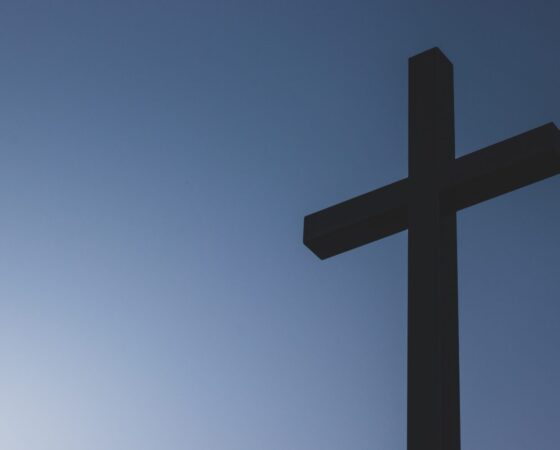WHERE DO YOU PUT YOUR JESUS STATUE? | A Sermon based on Mark 8:27-38 (RCL) | SECOND SUNDAY IN LENT, FEBRUARY 28, 2021 | by David Zersen |
Jesus went on with his disciples to the villages of Caesarea Philippi; and on the way he asked his disciples, “Who do people say that I am?” And they answered him, “John the Baptist; and others, Elijah; and still others, one of the prophets.” He asked them, “But who do you say that I am?” Peter answered him, “You are the Messiah.” And he sternly ordered them not to tell anyone about him.
Then he began to teach them that the Son of Man must undergo great suffering, and be rejected by the elders, the chief priests, and the scribes, and be killed, and after three days rise again. He said all this quite openly. And Peter took him aside and began to rebuke him. But turning and looking at his disciples, he rebuked Peter and said, “Get behind me, Satan! For you are setting your mind not on divine things but on human things.”
He called the crowd with his disciples, and said to them, “If any want to become my followers, let them deny themselves and take up their cross and follow me. For those who want to save their life will lose it, and those who lose their life for my sake, and for the sake of the gospel, will save it. For what will it profit them to gain the whole world and forfeit their life? Indeed, what can they give in return for their life? Those who are ashamed of me and of my words in this adulterous and sinful generation, of them the Son of Man will also be ashamed when he comes in the glory of his Father with the holy angels.”
WHERE DO YOU PUT YOUR JESUS STATUE?
Where do you put your Jesus statue? To me it has a lot to do with what that statue represents. Most of us have an image of Jesus or something that symbolizes him somewhere in our home or our office. Over the years I’ve collected a number of them and have observed what others have collected as well. My favorite statue was bought in a shop in Seoul, Korea. It’s an image of a Korean peasant with his arms outstretched. On his back he has a wicker basket in which peasants typically carry their burdens from the fields. In this case, the message has to do with Jesus being our burden barrier, a thought inviting all of us at different times in our lives. Another image I’ve seen recently is of Jesus wearing a red hat that says “Make America Great Again.” It’s clearly a political statement representing those who think Donald Trump and Jesus have struck a bargain and are working together to achieve a better future. Another image that I once saw in Africa portrayed a light-skinned, blue-eyed Jesus with blonde hair looking very Hollywoodish to me. Perhaps it was sent from an American Sunday School or in this hi-tech age purchased online. It may have represented to some a first-world Jesus, a Jesus who guaranteed success or hope.
Depending, of course, on what a particular Jesus image may mean to you could determine how you would use it or where you put it? I’ve seen the picture of the blue-eyed, blonde-haired Jesus in a Sunday School classroom for impoverished children in Mexico and I’ve asked myself what it could possibly mean to them. I’ve seen the image of the “Make America Great Again” Jesus at the Jan. 6 riot before the U.S.capitol and I asked myself as well: “What is he doing there”? And I regularly see my Korean peasant Jesus on my bookcase reminding me of the biblical passage, “Cast all your care on him for he cares for you.”
Who will you let Jesus be for you?
In today’s Gospel lesson, Jesus takes his disciples to Caesarea Philippi, an out-of-the-way place in northern Israel known best to non-Jews who settled there over the centuries. There one finds a well-known rock wall in the niches of which images of religious figures could be placed. Over the centuries, Baal, Pan and even some of the Caesars have been revered there. Yet it is there that Jesus asks his disciples in our text, “Who do people say that I am?” and “Who do you say that I am?” Considering the options that the background wall provides, the disciples say, “Elijah. John the Baptist.” Peter says, “The Messiah.” Yet even Peter could not have imagined what kind of a Messiah Jesus was. When Jesus went on to describe the kind of Messiah he was going to be, one who suffered and was rejected, one who would be killed and rise again, Peter tried to straighten him out. He was sure that such a Jesus would not go over with anyone, would not be anyone’s choice for a messiah, and would certainly never be placed on someone’s bookcase!
There are many kinds of acceptable messiahs that people might consider and it’s worth recounting some of them. Some of them make people comfortable and they seem relatively reasonable. There’s the Jesus who heals the troubled in mind and body. At the base of that sculpture we could place the banner: “He cares for me.” There’s the Jesus preached by prosperity-gospel TV evangelists who will make you rich if you follow him. At that basis of that Jesus statue the banner could read “Give and it will be given to you.” And there’s the Jesus who defends us from our enemies in challenging times. The banner under his statue can read: “Jesus is our advocate.” Such imagery has truth in it, but the focus is largely on what should be done for us. Jesus is our Savior and that’s wonderful to hear. However, in being our Savior he also shows us something about himself that propels us into a commitment toward others.
It’s one thing to let Jesus do something for us, but it’s more important that Jesus also transforms us. We have all heard sayings like “Saved to serve” or “Claimed to be a Servant.” At first the disciples of Jesus had great difficulty understanding what their master’s claim involved for them. They were followers, sometime evangelists who shared his message of hope and mercy and sometime healers who demonstrated that God was concerned about both mind and body. Such a growing understanding came to a halt however at the crucifixion. After the master was dead, they went into hiding. His fate could be theirs as well. What had been the point of their discipleship? Perhaps they had all been fools. Perhaps they should go back home. Or?
Gradually they came to understand that the crucifixion was a part of Jesus’ being the very messiah they hadn’t expected. Whether they thought he would lead them against the Romans or begin a new challenge to the Pharisees, this wasn’t the messiah they awaited. It took a while for them to realize that the very one who had been ignoring his personal needs to feed the hungry, caring for the troubled in mind and body and ignoring petty prejudices was the very same one who went to the cross to lead them beyond hatred, anger, cruelty and injustice. The crucifixion that he willingly accepted was his ultimate mercy for us, his insistence that no one needs to live a life of petty violence and egotistic, selfish jealously. When he said “It is finished” at the cross, he was assuring more than that he had died. He had provided for us a new kind of leadership, a new way of puting love at the center of our lives. This was not just a goodie-two-shoes Jesus. This was God-in-man saying: “Behold, I make all things new.”
When will Jesus be the Messiah for you?
There is something surprising and immediate about this Jesus who wants to have a place in your life this day. We may all have been baptized and thus commissioned to live as those who have rejected the power of evil in our midst. We may regularly dine at the Lord’s table with our brothers and sisters in Christ and claim our place in the family of God. But there is something that is still calling us today. There may be a besetting sin, a practice, a privilege, a style, a greed, an anger that we can’t release. We know who we are as children of God, but we are still waiting for that moment when God will surprise us with the power that sets us free.
Some of us are faithful viewers of a British mystery called “Vera”. It’s an hour-and-a-half story with no commercials on PBS in which a dowdy middle-aged matron runs hither and yon, investigates every possible lead, but never discovers the actual murderer until the last ten minutes of the program! As we meet character after character in the drama we can be led to ask “Is this the one or do we wait for another”? It is the question that people ask in general as the messiahs of the world beckon us. We may grow up a Christians as some say, “baptized, confirmed, the whole bit!” Still, we may be introduced to other messiahs who assure that they have something to offer. Their names may be New Age, Neo Pagan or even Q Anon. Who knew?
Most of us, hopefully, like Vera, will know that the one who at the end of the story is the only one who it could have been, will wait confidently, as temptations arise, to pass over the false prospects. The one thing all false messiahs have in common is that they point us to ourselves, to the need that we have to be the most important person in our lives. False messiahs preach a prosperity gospel like too many TV evangelists, a power gospel like politicians who want to rally those who need their country to be at the top of the heap. False messiahs preach a blame gospel that wants to identify the people who led us wrong or a cheap gospel (as Bonhoeffer reminded us) in which nothing has to happen other than loving a graceful God.
My Jesus statue has to have a prominent place in my home because it says something to me about the new life into which the true Messiah is calling us. People who see my Jesus statue need to know something about the Messiah in which I place my hope. Jesus, the Lord of Lords, knew that the way of thinking that places the self first, also brought humanity to a dead end. He went right to the heart of the matter by ending false priorities and dead-end streets at the cross. “This stops here,” he said. “Behold, I make all things new.”
We begin again here together. “Rise with me to a new life,” Jesus is asking, “a new beginning in my resurrection.” It will be a life focused on love for others, care for those with needs and the confidence that mercy and forgiveness offer more than justice and resentment.
The only question that remains is when you will let this Messiah, this Jesus, be the one among all other claimants who take s his place on your bookcase, on your mantel, on your wall, as the proof that while others are still trying to decide who the right one is, you’ve found him and will never let him go.
Suggested hymns: Jesus I will never leave (Meinen Jesum lass’ ich nicht)
—
The Rev. David Zersen, Ed.D., FRHistS
President Emeritus, Concordia University Texas

